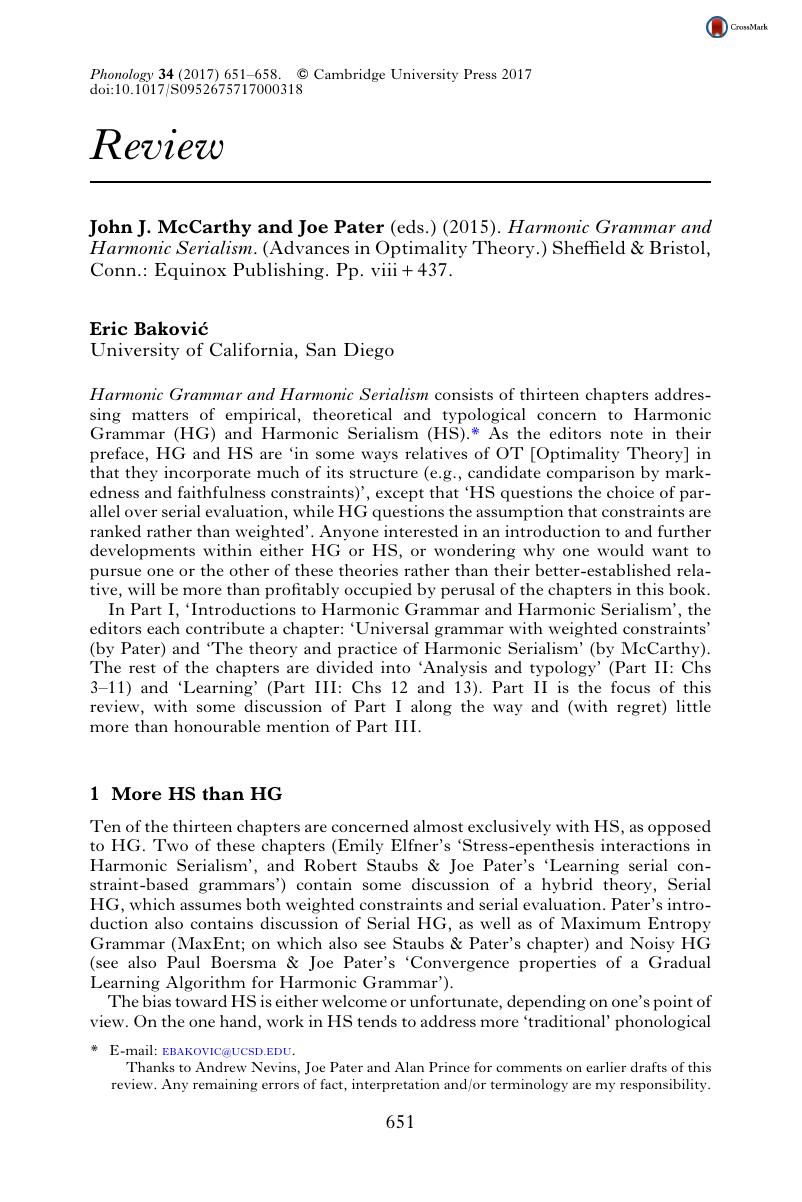No CrossRef data available.
Article contents
John J. McCarthy and Joe Pater (eds.) (2015). Harmonic Grammar and Harmonic Serialism. (Advances in Optimality Theory.) Sheffield & Bristol, Conn.: Equinox Publishing. Pp. viii+437.
Published online by Cambridge University Press: 19 December 2017
Abstract
An abstract is not available for this content so a preview has been provided. Please use the Get access link above for information on how to access this content.

- Type
- Review
- Information
- Copyright
- Copyright © Cambridge University Press 2017
Footnotes
*
Thanks to Andrew Nevins, Joe Pater and Alan Prince for comments on earlier drafts of this review. Any remaining errors of fact, interpretation and/or terminology are my responsibility.
References
REFERENCES
Adler, Jeffrey (2017). Parallelism and conspiracy: implications for parallel versus serial derivation. MA thesis, University of California, Santa Cruz. Available at http://escholarship.org/uc/item/1d63t2g8.Google Scholar
Adler, Jeffrey & Zymet, Jesse (to appear). Irreducible parallelism in phonology. NELS
47. Pre-print version available as ROA-1323 from the Rutgers Optimality Archive.Google Scholar
Alber, Birgit, DelBusso, Natalie & Prince, Alan (2016). From intensional properties to universal support. Language
92. e88–e116.Google Scholar
Alderete, John (1999). Head dependence in stress-epenthesis interactions. In Hermans, Ben & van Oostendorp, Marc (eds.) The derivational residue in phonological Optimality Theory. Amsterdam & Philadelphia: Benjamins. 29–50.Google Scholar
de Lacy, Paul (2002). The formal expression of markedness. PhD dissertation, University of Massachusetts, Amherst.Google Scholar
Flemming, Edward (2013). A note on parallel and serial derivations. Class handout, MIT. Available (August 2017) at web.mit.edu/~flemming/www/paper/Parallel_serial.pdf.Google Scholar
Garrett, Edward (1999). Minimal words aren't minimal feet. UCLA Working Papers in Linguistics
1: Papers in Phonology
2. 68–105.Google Scholar
Honma, Takeru, Okazaki, Masao, Tabata, Toshiyuki & Tanaka, Shin'ichi (eds.) (2003). A new century of phonology and phonological theory: a Festschrift for Professor Shosuke Haraguchi on the occasion of his sixtieth birthday. Tokyo: Kaitakusha.Google Scholar
Ito, Junko & Mester, Armin (2003). Weak layering and word binarity. In Honma,
et al. (2003). 26–65.Google Scholar
Jesney, Karen (2011). Positional faithfulness, non-locality, and the Harmonic Serialism solution. NELS
39. 429–440.Google Scholar
Legendre, Géraldine, Miyata, Yoshiro & Smolensky, Paul (1990). Harmonic Grammar: a formal multi-level connectionist theory of linguistic well-formedness: theoretical foundations. In Proceedings of the 12th Annual Conference of the Cognitive Science Society. Hillsdale: Erlbaum. 388–395.Google Scholar
Legendre, Géraldine, Sorace, Antonella & Smolensky, Paul (2006). The Optimality Theory–Harmonic Grammar connection. In Smolensky, Paul & Legendre, Géraldine (eds.) The harmonic mind: from neural computation to optimality-theoretic grammar. Vol. 2: Linguistic and philosophical implications. Cambridge, Mass.: MIT Press. 339–402.Google Scholar
McCarthy, John J. (2007). Hidden generalizations: phonological opacity in Optimality Theory. Sheffield & Bristol, Conn.: Equinox.Google Scholar
McCarthy, John J. (2013). Irreducible parallelism and desirable serialism. Paper presented at the 2013 Meeting on Phonology, University of Massachusetts Amherst. Slides available (August 2017) at http://blogs.umass.edu/phonology-2013/files/2013/08/Irreducible-Parallelism-Slides.pdf.Google Scholar
Magri, Giorgio (2013). HG has no computational advantages over OT: toward a new toolkit for computational OT. LI
44. 569–609.Google Scholar
Merchant, Nazarré (2015). Recursive Join Learning using Candidate Maps. Ms, Eckerd College. Available as ROA-1232 from the Rutgers Optimality Archive.Google Scholar
Merchant, Nazarré & Prince, Alan (to appear). The mother of all tableaux. London: Equinox. Available as ROA-1285 from the Rutgers Optimality Archive.Google Scholar
Pater, Joe, Bhatt, Rajesh & Potts, Chris (2007). Linguistic optimization. Ms, University of Massachusetts, Amherst. Available as ROA-924 from the Rutgers Optimality Archive.Google Scholar
Potts, Christopher, Pater, Joe, Jesney, Karen, Bhatt, Rajesh & Becker, Michael (2010). Harmonic Grammar with linear programming: from linear systems to linguistic typology. Phonology
27. 77–117.Google Scholar
Prince, Alan (2006). Harmony at Base Omega: utility functions for OT. Ms, Rutgers University. Available as ROA-798 from the Rutgers Optimality Archive.Google Scholar
Prince, Alan (2007a). Let the decimal system do it for you: a very simple utility function for OT. Available as ROA-943 from the Rutgers Optimality Archive.Google Scholar
Prince, Alan (2007b). The pursuit of theory. In de Lacy, Paul (ed.) The Cambridge handbook of phonology. Cambridge: Cambridge University Press. 33–60.Google Scholar
Prince, Alan (2016). What is OT? Available as ROA-1271 from the Rutgers Optimality Archive.Google Scholar
Prince, Alan & Smolensky, Paul (1993). Optimality Theory: constraint interaction in generative grammar. Ms, Rutgers University & University of Colorado, Boulder. Published 2004, Malden, Mass. & Oxford: Blackwell.Google Scholar
Prince, Alan, Tesar, Bruce & Merchant, Nazarré (2013). OTWorkplace. Software package. https://sites.google.com/site/otworkplace.Google Scholar
Selkirk, Elisabeth (1995). The prosodic structure of function words. In Beckman, Jill N., Dickey, Laura Walsh & Urbanczyk, Suzanne (eds.) Papers in Optimality Theory. Amherst: GLSA. 439–469.Google Scholar
Staubs, Robert, Becker, Michael, Potts, Christopher, Pratt, Patrick, McCarthy, John J. & Pater, Joe (2010). OT-Help 2.0. Software package. http://people.umass.edu/othelp.Google Scholar
Tesar, Bruce (2007). A comparison of lexicographic and linear numeric optimization using violation difference ratios. Ms, Rutgers University. Available as ROA-939 from the Rutgers Optimality Archive.Google Scholar
Zymet, Jesse (2016). A case for parallelism: reduplication-repair interaction in Maragoli. Paper presented at the 90th Annual Meeting of the Linguistic Society of America, Washington, DC. Available (August 2017) at http://www.linguistics.ucla.edu/people/grads/jzymet.Google Scholar


